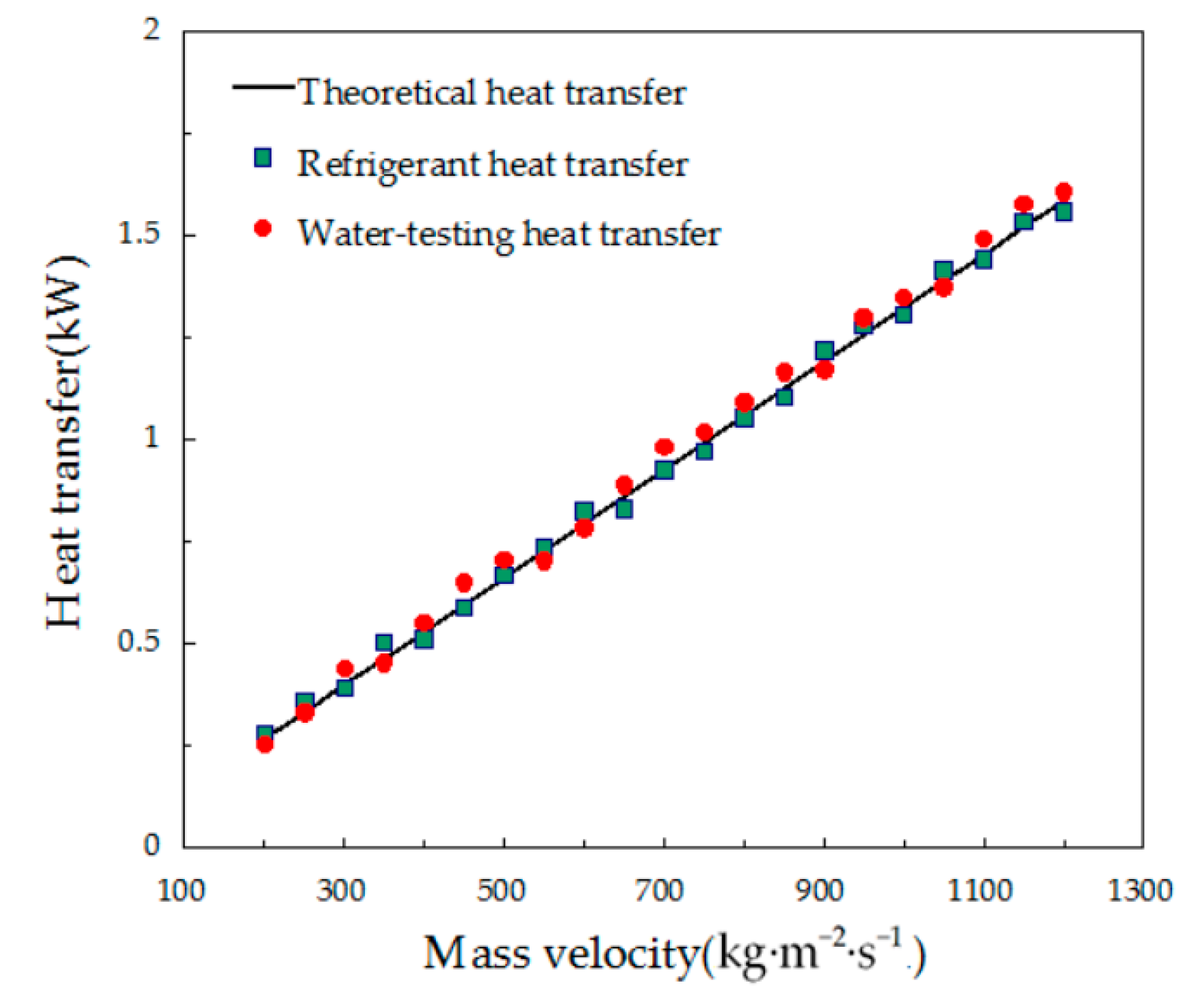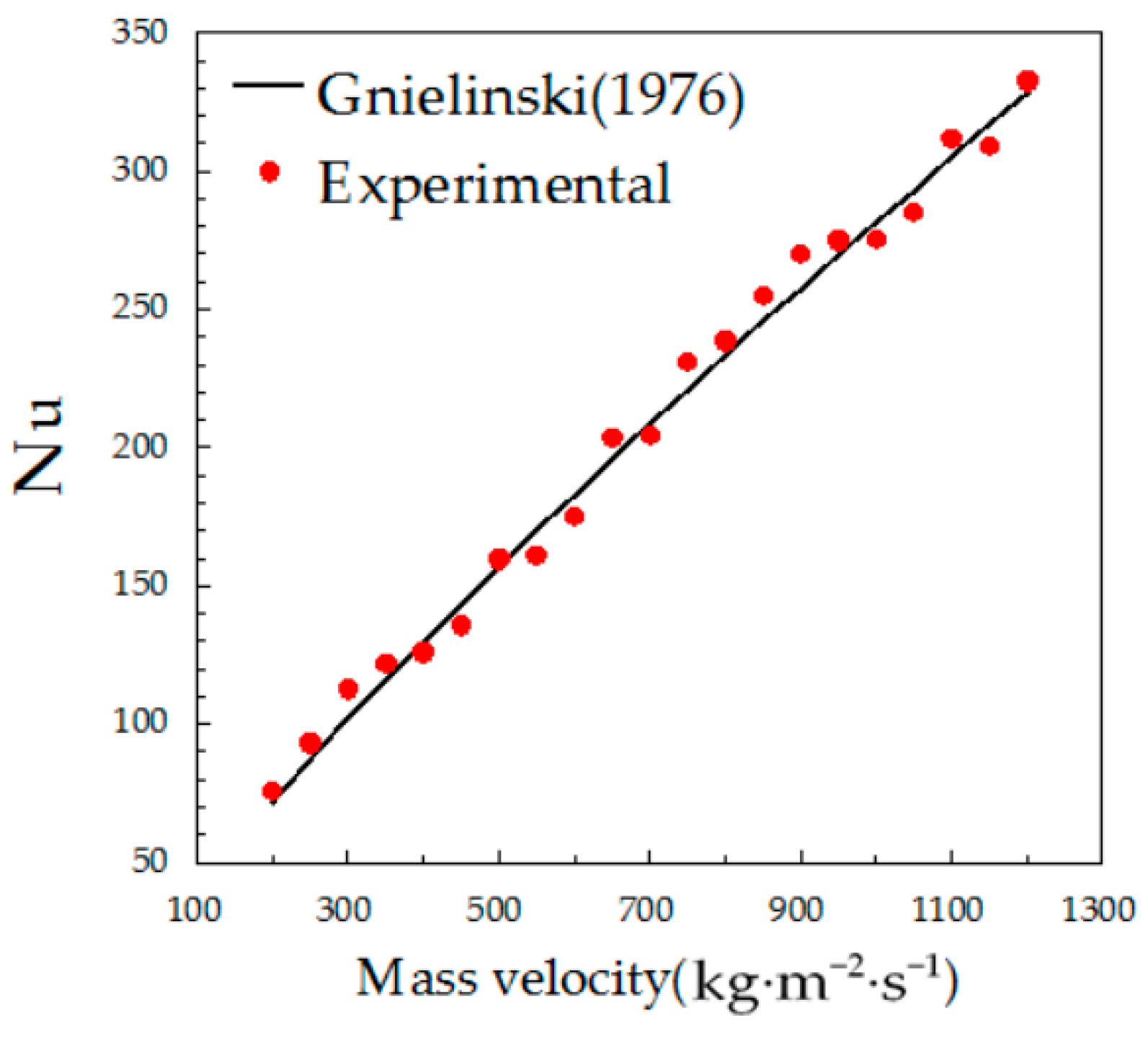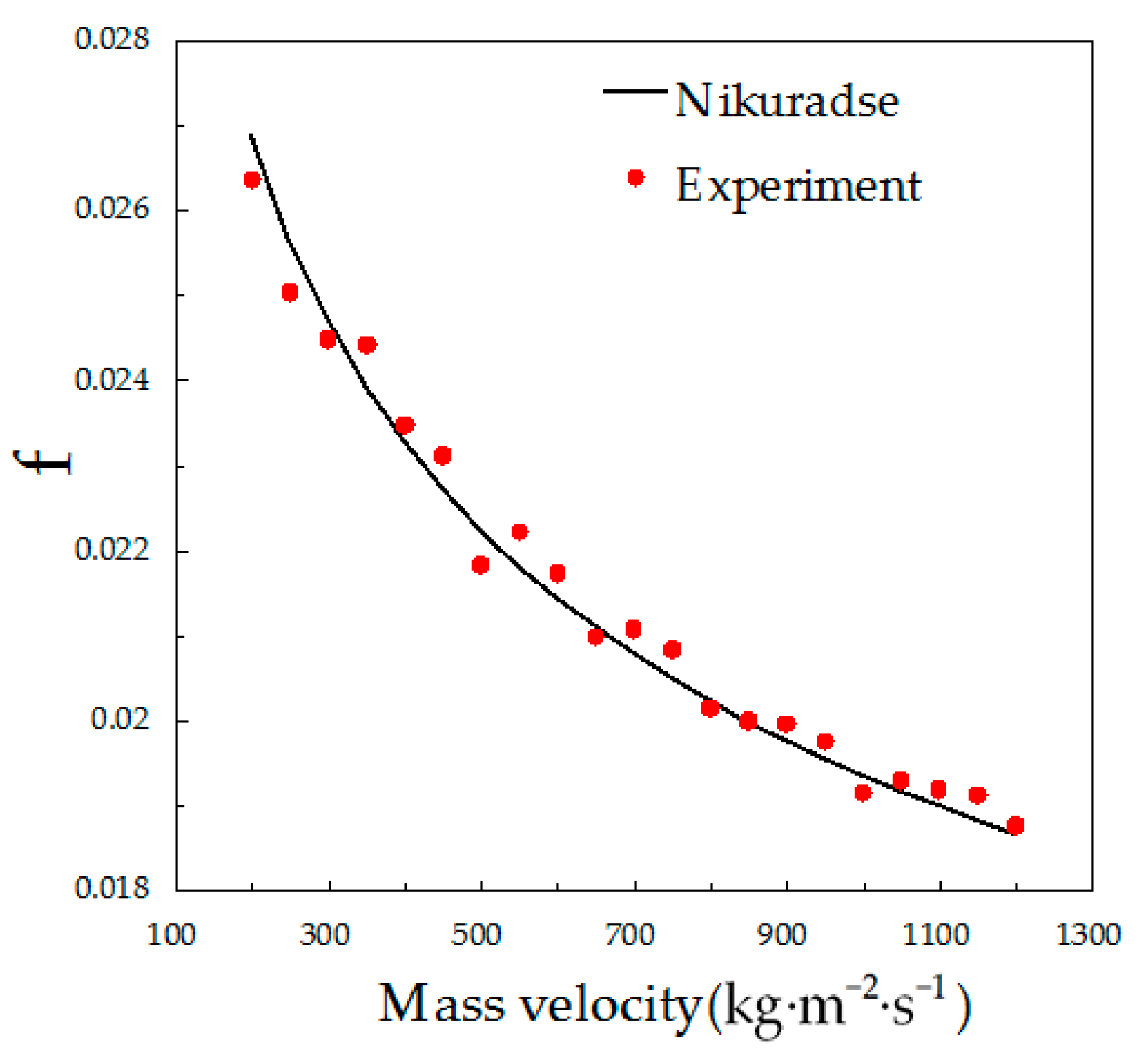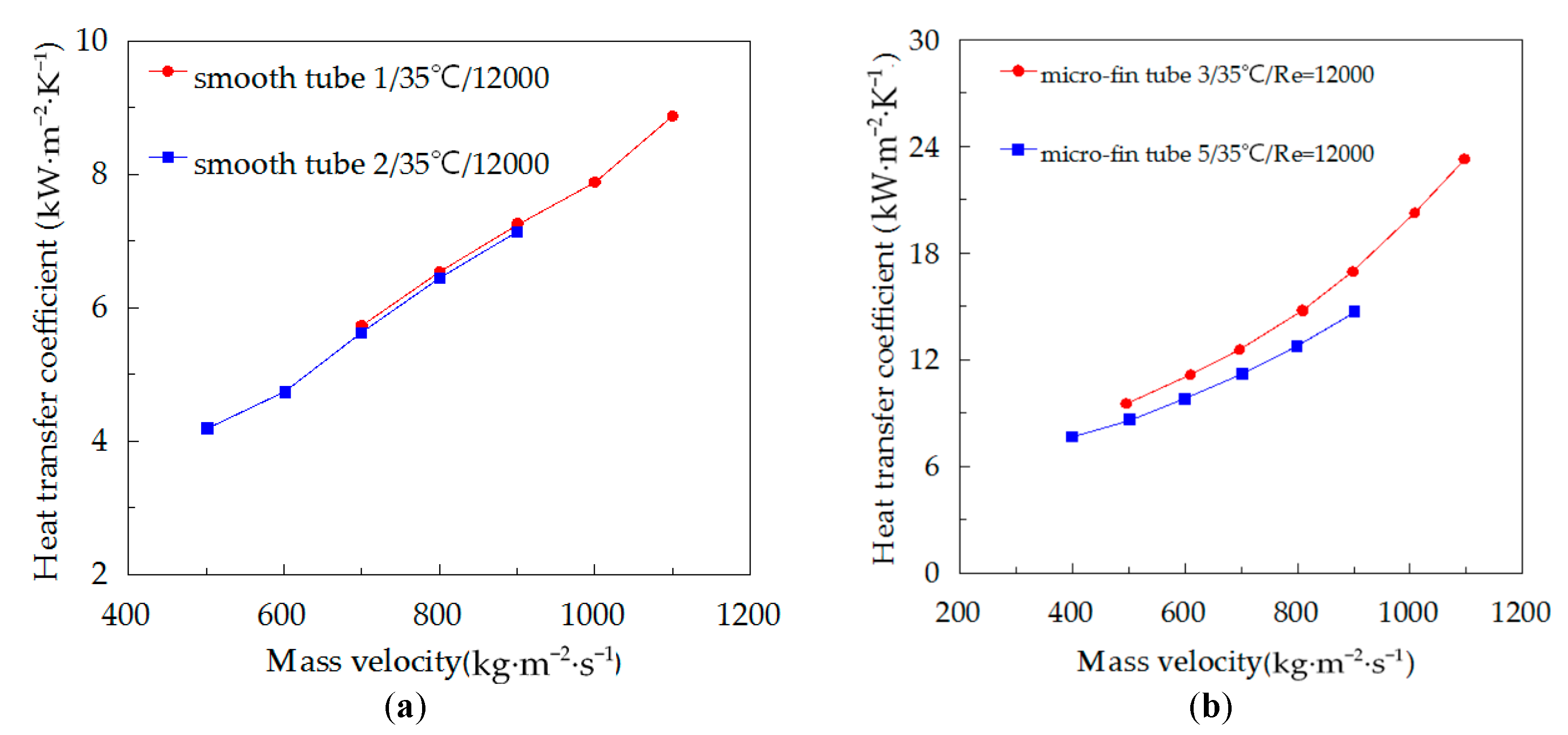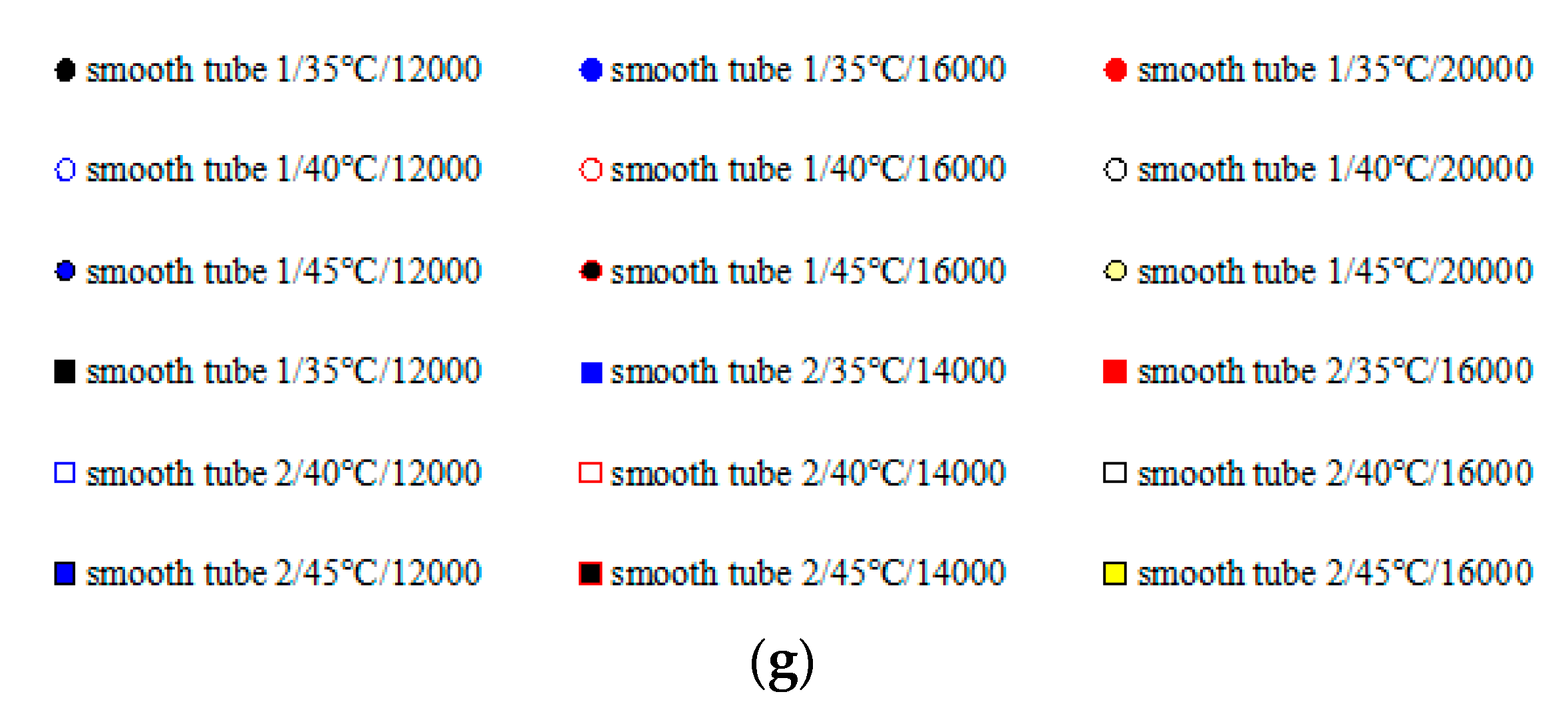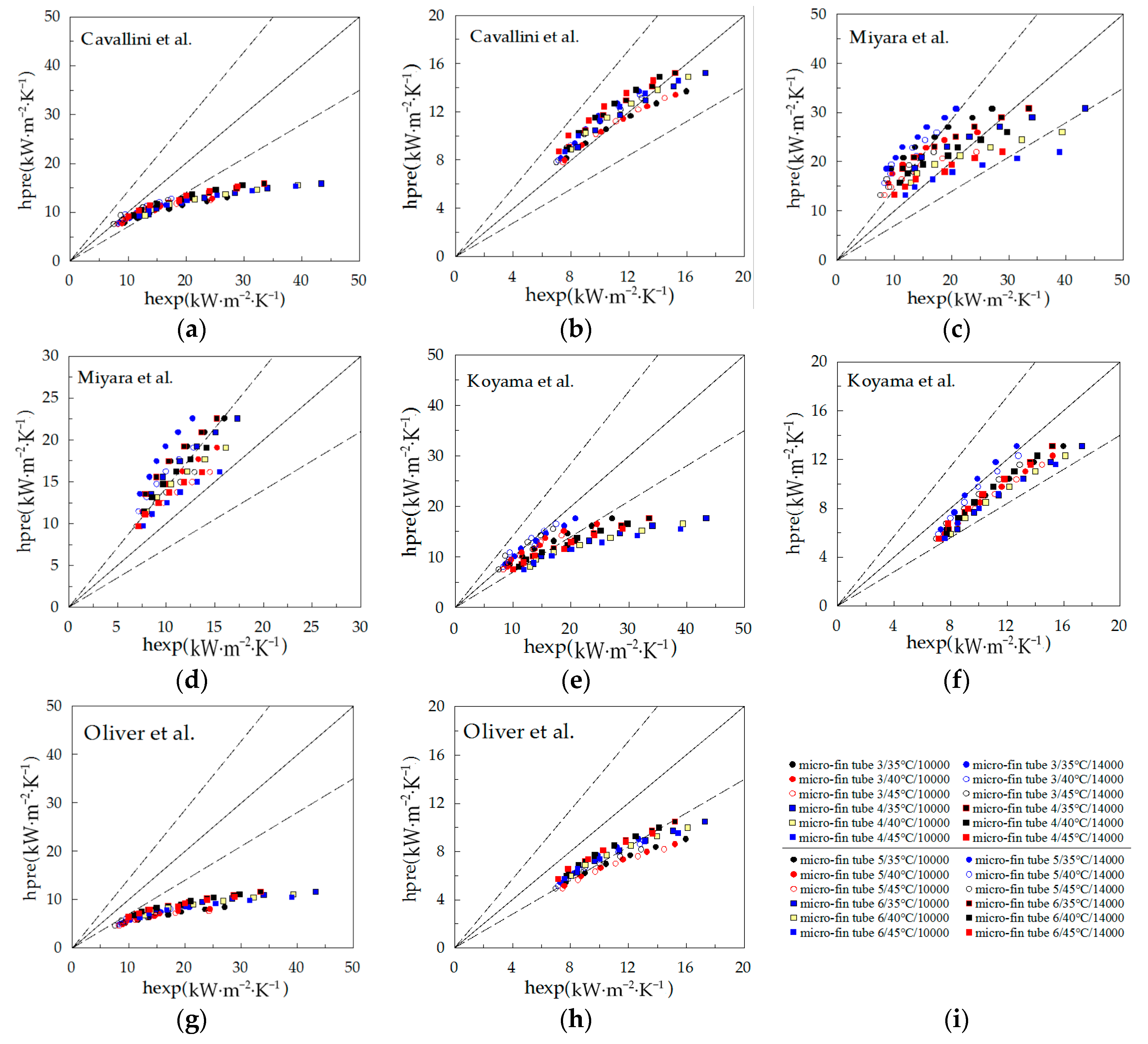3.1. Single-Phase Heat Transfer Experiment
To ensure the accuracy of measuring parameters, the single-phase condensation heat transfer and pressure drop experiments of liquid R134a in the smooth tube with an inner diameter of 12.7 mm were carried out before any two-phase experiments, with the mass velocity ranging from 200 to 1200 kg·m−2·s−1 (corresponding to Reynolds number ranging from 12,500 to 74,500) and the condensation temperature of 30–40 °C.
Figure 4 shows the comparison of the heat transfer rate between refrigerant/water-testing and theoretical value. The refrigerant/water-testing experimental values agree well with the theoretical values, and deviations of the heat transfer rate between refrigerant and water testing are within 5%, showing that the heat leakage is small enough to meet the condensation experiment requirements.
The comparison between experimental and theoretical Nusselt-based on the Gnielinski correlation is shown in
Figure 5, experimental results are similar to the research results of Oh et al. [
32]: the experimental value agrees well with the theoretical value with the average and root-mean-square deviations of 3.4% and 12.8%, respectively, which is enough to prove the reliability of experiment. Since the mean value of refrigerant temperatures at the inlet and outlet of the test section was regarded as a reference temperature, the fact that the non-linear refrigerant thermophysical properties vary with increasing temperature results in a difference between experimental and theoretical values, although there are measurement errors of the temperature and pressure transducers. The comparison between experimental and theoretical friction factor based on the Nikuradse correlation is also shown in
Figure 6, and results show that the experimental value agrees well with the theoretical value, with the average and root-mean-square deviations of 1.2% and 4.4%, respectively.
R134a was used as the refrigerant in the two-phase condensation experiment, and
Table 3 lists the properties of R134a under the working conditions. The experiment was performed under the following conditions: mass velocities of 400–1100 kg·m
−2·s
−1, water-testing Reynolds numbers of 8000–22,000 and condensation temperatures of 35–45 °C, as listed in
Table 4.
3.2. Two-Phase Heat Transfer Experiment
The condensation heat transfer experiments of R134a inside two smooth and four micro-fin tubes were operated for mass velocities of 400–1100 kg·m
−2·s
−1, condensation temperatures of 35 °C, 40 °C, and 45 °C, and water-testing Reynolds numbers of 8000–22,000. The heat transfer coefficient was chosen as the evaluation index and the working conditions and structural parameters of the test tube were selected as influencing factors in the experiment. The refrigerant two-phase flow pattern inside the test tube was identified as the annular flow based on the Hajal et al. [
33] flow pattern map under all working conditions.
To study the influences of mass velocity and condensation temperature, comparisons of the heat transfer coefficient of R134a at various mass velocities were made with condensation temperatures of 35 °C, 40 °C and 45 °C inside tubes 2, 5, and 6, as shown in
Figure 7. Results show although the value added of unit mass velocity becomes bigger at a larger mass velocity, especially for the smooth tube, the heat transfer coefficient linearly increases with increasing mass velocity. This is because the vapor velocity and the liquid velocity all increase with increasing mass velocity for constant vapor quality, and the vapor velocity increases faster than that of liquid, causing the heat transfer boundary layer to be thinner and the turbulence intensity to increase. The increase of condensation temperature results in the increase of condensation pressure and vapor density, resulting in the velocity contrast of refrigerant vapor and liquid being decreased and a decrease of shear force at the interface of the vapor–liquid phase. In addition, the liquid thermal conductivity and surface tension decrease with the increase of temperature; all of these can result the heat transfer coefficient increasing with decreasing condensation temperature. In addition, with every 5 °C reduction in condensation temperature, the added value of the heat transfer coefficient is similar, due to the fact that the refrigerant thermo-physical properties are linear with condensation temperature.
Figure 8 compares the heat transfer coefficients of R134a at various water-testing Reynolds number, with mass velocities of 500 kg·m
−2·s
−1, 700 kg·m
−2·s
−1 and 900 kg·m
−2·s
−1 and condensation temperature of 45 °C. The heat transfer coefficient decreases with increasing water-testing Reynolds number, and the influence of water-testing Reynolds number on the heat transfer coefficient is not significant for smooth tube while it becomes significant for micro-fin tube. To meet the heat transfer requests in the test section, the log-mean temperature difference increases with decreasing water-testing Reynolds number, which can cause the temperature gradient of boundary layer to become larger; hence the influence of water-testing Reynolds number can be extended to the influence of the boundary layer temperature gradient on the heat transfer coefficient. As mentioned above, the refrigerant thermo-physical properties for heat transfer improve with the decrease of temperature.
Research on the influence of tube diameter on the heat transfer coefficient has been performed by many scholars [
34,
35,
36], but there is no a uniform result.
Figure 9 shows the influence of tube diameter on the heat transfer coefficient for a condensation temperature of 35 °C and water-testing Reynolds number of 12,000 inside two smooth tubes and two micro-fin tubes with different inner diameters. Tube diameter has a small influence on the heat transfer for smooth tubes, as seen in the study from Baird et al. [
34], while the heat transfer coefficient increases with decreasing tube diameter for micro-fin tubes. This can be explained by the interference of the micro-fin; apart from the different inner diameter, the micro-fin tubes 3 and 5 have micro-fins with the same height. A large ratio of fin height to inner diameter contributes to increasing the refrigerant turbulence, and then enhances heat transfer effect.
The relationship between the heat transfer coefficient and mass velocity with water-testing Reynolds number of 12,000 and condensation temperature of 35 °C inside two smooth and four micro-fin tubes is represented in
Figure 10. The heat transfer coefficient of micro-fin tubes with a helix angle of 28° is the highest and the heat transfer capacity of smooth tubes is the poorest among test tubes with the same diameter. The heat transfer enhancement ratio is 3.23–5.37, 2.21–2.54 for micro-fin tubes 4 and 6, respectively. The heat transfer enhancement ratio is 2.19–2.87, 2.12–2.21 for micro-fin tubes 3 and 5, respectively. The complex interactions between the structural parameters of micro-fin tube and refrigerant thermo-physical properties cause an enhancement effect of micro-fin tube. The surface area remains constant for all working conditions. The enhancement by liquid drainage decreases with increasing mass velocity, which has been confirmed by experiment [
37], hence interfacial turbulence is a major factor of the heat transfer enhancement. Apart from the interfacial turbulence increases with the increase of liquid and vapor velocities, a larger helix angle can also cause stronger turbulence. This is why the heat transfer coefficients micro-fin tubes 3 and 5 are in the middle.
3.3. Comparison with Existing Correlations
There exist some deviations between the experimental data and the correlation theoretical value due to the fact that the two experiments could not be exactly the same, especially for the following elements: working conditions, structural parameters of the test tube, algorithm, measurement accuracy of apparatus and so on. According to the previous studies, a prediction accuracy of less than 30% was defined as an acceptable deviation in the experiment.
Condensation heat transfer characteristics of all types refrigerant inside the horizontal smooth tube have been studied for years and many correlations have been developed, meanwhile, continuous improvement of correlations has also been made for various alternative refrigerants and new type heat exchangers. In this experimental analysis, six well-known correlations by Cavallini et al. [
38], Shah [
6], Thome et al. [
39], Akers et al. [
7], Dobson and Chato et al. [
9] and Jung et al. [
40] were applied to compare the heat transfer coefficient of smooth tubes. Comparisons of the heat transfer coefficient between the predictive values and experimental values varying with mass velocity are shown in
Figure 11, and
Table 5 lists the deviation of various correlations against experimental heat transfer coefficient.
Since the actual working conditions gradually approach the assumed conditions of the Cavallini et al. correlation with increasing mass velocity for a constant vapor quality, the Cavallini et al. correlation predicts the experimental data very well for two smooth tubes with mean absolute deviation of 13.05%. Although the Shah and Thome et al. correlations overestimate the experimental data, they still can capture the heat transfer coefficient with a mean absolute deviation of 26.07% and 23.82%, respectively. This is because the increase of vapor and liquid velocities with increasing mass velocity results in the increase of shear stress, eventually causing liquid film to be evenly distributed. The effect of gravity can be ignored, in other words, heat transfer mechanism of forced-convection takes an increasingly dominant role with the increase of mass velocity. The Akers et al. correlation underestimates the heat transfer coefficient and has deviations from 20 to 40%, therefore, there exists a certain defect of the experimental data prediction. It is obvious that the predictive abilities of correlations of Dobson and Chato et al. and Jung et al. are poor, with mean absolute deviation of 140.18% and 146.23%, respectively, though they have higher prediction accuracy in a small mass flux based on the previous experimental investigations.
Meanwhile, the experimental data for the micro-fin tube was also compared with widely used correlations: the Cavallini et al. correlation [
13], the Miyara et al. correlation [
14], the Koyama et al. correlation [
41], and the Oliver et al. correlation [
18]. Detailed comparison results are shown in
Figure 12, and deviations of various correlations against the experimental data are also listed in
Table 5.
For micro-fin tubes 3 and 4, while the Miyara et al. correlation overestimates the heat transfer coefficient, correlations of Cavallini et al., Koyama et al. and Oliver et al. underestimate the experimental data and their predictive errors increase with the increase of mass velocity. The Miyara et al. correlation was proposed based on the experiment data in a herringbone-type micro-fin tube. Although condensate film inside the tube is invisible, one thing is for sure: the enhancement mechanism in detail is different for the enhanced tubes with different structure, and the heat transfer coefficient of the herringbone-type micro-fin tube is higher than that of the helical micro-fin tube based on previous research. For the correlations of Cavallini et al. and Koyama et al., since the experimental data was obtained under working condition of a small mass velocity, and the heat transfer mechanism did not take into account for large mass velocity, a very large error between the predictive value and experimental value exists at large mass velocity. The Oliver et al. correlation underestimates the experimental data with mean absolute deviation of 54.48%, hence it does not apply to predict the heat transfer coefficient in this study. However, all correlations have high prediction accuracy for micro-fin tubes 5 and 6; the correlations of Cavallini et al. and Miyara et al. present the best predicting results with mean absolute deviation of 6.62% and 4.73%, respectively. Although the correlations of Koyama et al. and Oliver et al. underestimate the experimental data, their prediction errors keep to within 30%. Except increasing the heat transfer area, the mixing of condensate film is a dominant factor of enhancement of condensation heat transfer for the micro-fin tube, which may cause the different predictive effects of correlations for micro-fin tubes with different inner diameters.
Given that distribution of condensate film becomes more uniform, that thickness decreases with increasing mass velocity for a constant vapor quality, and that the Reynolds number is used to characterize the refrigerant flow regime, dimensionless parameters that characterize fluid turbulence in the correlation (including not only Reynolds number) were modified to improve their prediction accuracy. For smooth tubs, a dimensionless parameter
that characterizes the two-phase flow dynamic viscosity was introduced to the correlations of Dobson and Chato et al. and Jung et al., and the modified Dobson and Chato et al. correlation and modified Jung et al. correlation can predict the experimental data very well with mean absolute deviations of 20.31% and 23.24%, respectively. That is to say, their errors can be limited to the level of 30%, as shown in
Figure 13a,b.
In the study of Guo et al. [
42], the Oliver et al. correlation underestimates the heat transfer coefficient when the original value of the variable “s” is set to 0.715, while the predictive ability is improved and most predicted data can be controlled within a 30% error range when this value is set to 0.745, which provides a reference for the correlation modification. Re
eq is the equivalent Reynolds number in the correlations of Cavallini et al. and Oliver et al., and Re
L is the two-phase Reynolds number in the Koyama et al. correlation. They are applied to characterize the influence of turbulence effect on the heat transfer coefficient. The exponent to the equivalent Reynolds number is defined as 0.7 for helical micro-fin tubes in the Oliver et al. correlation and 0.8 in the Cavallini et al. correlation, and the exponent to the two-phase Reynolds number is set as 0.4 in the Koyama et al. correlation. That the correlation underestimates the experimental data shows that the forced-convection heat transfer effect has not obtained enough attention for a large mass velocity in the correlation, hence, the modified correlation is intended to enhance the turbulence effect. The influence of turbulence effect on heat transfer coefficient was modified by changing the exponent to the Reynolds number in the calculation. That the exponent and refrigerant mass velocity have a small linear relationship was discovered through the experimental data and theoretical value iterative calculation; the specific calculation procedure is:
Experimental results show that the modified correlations of Cavallini et al., Koyama et al. and Oliver et al. can predict the heat transfer coefficient with mean absolute deviation of 13.06%, 5.37% and 16.13% for micro-fin tubes 3 and 4, respectively. The specific modification of all modified correlations is shown in
Table 6.
Since the herringbone-type micro-fin tub and helical micro-fin tub have different structural parameters of the micro-fin, and the ratio of the fin height to inner diameter that has a significant influence on the mixing of the condensate film is different for test micro-fin tubes with different inner diameters, the correlation was not modified through the enhancement of turbulence effect only. There exist many works obtaining a general correlation with a high prediction accuracy for all test tubes and with a wide working condition region.



